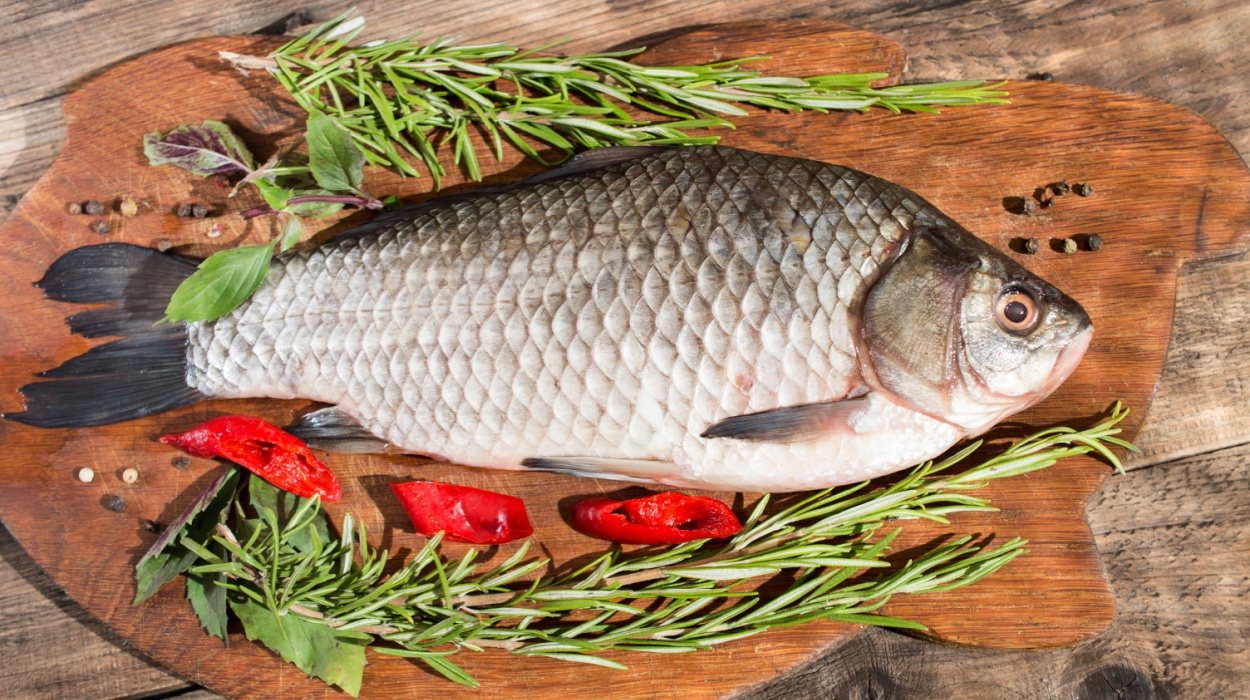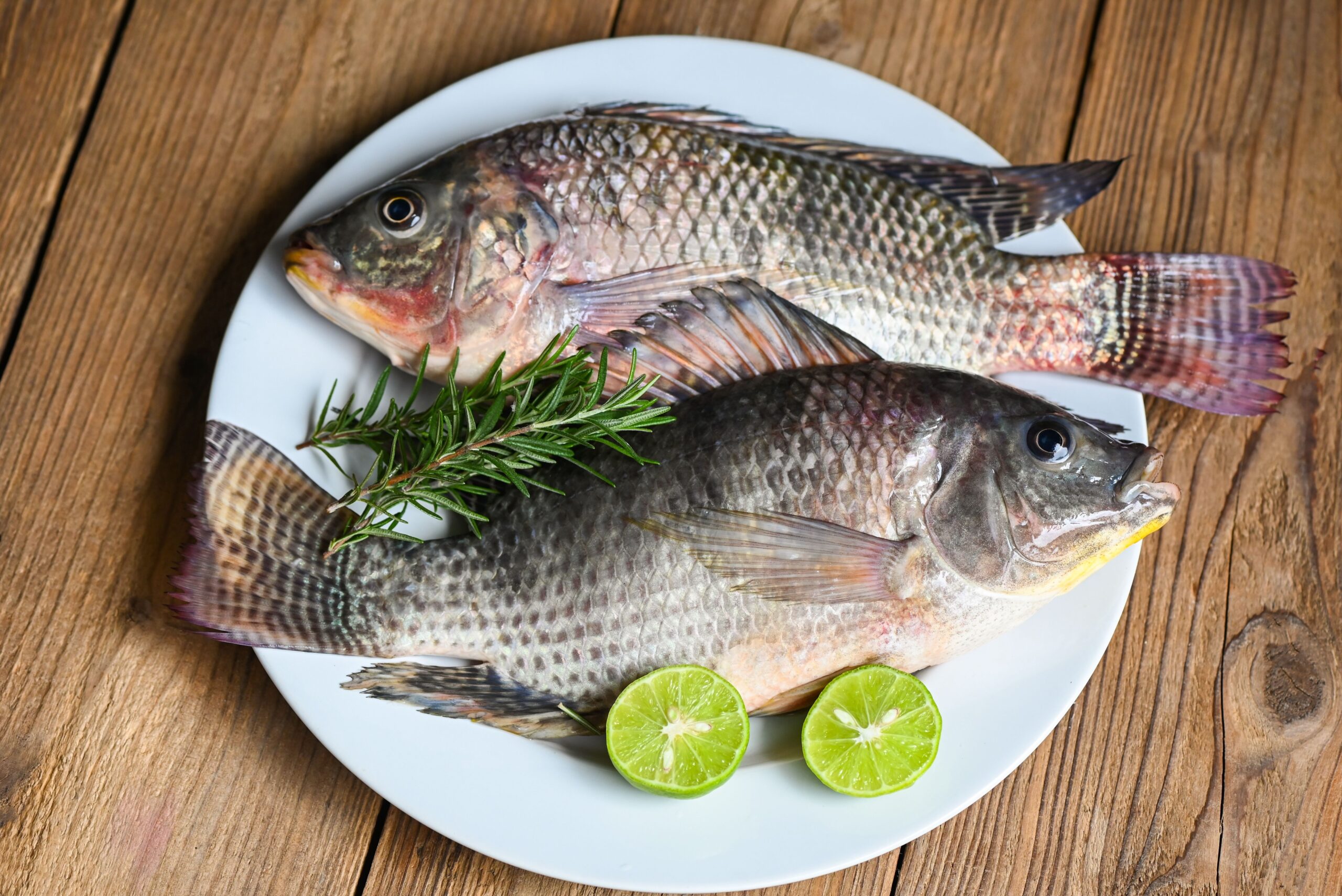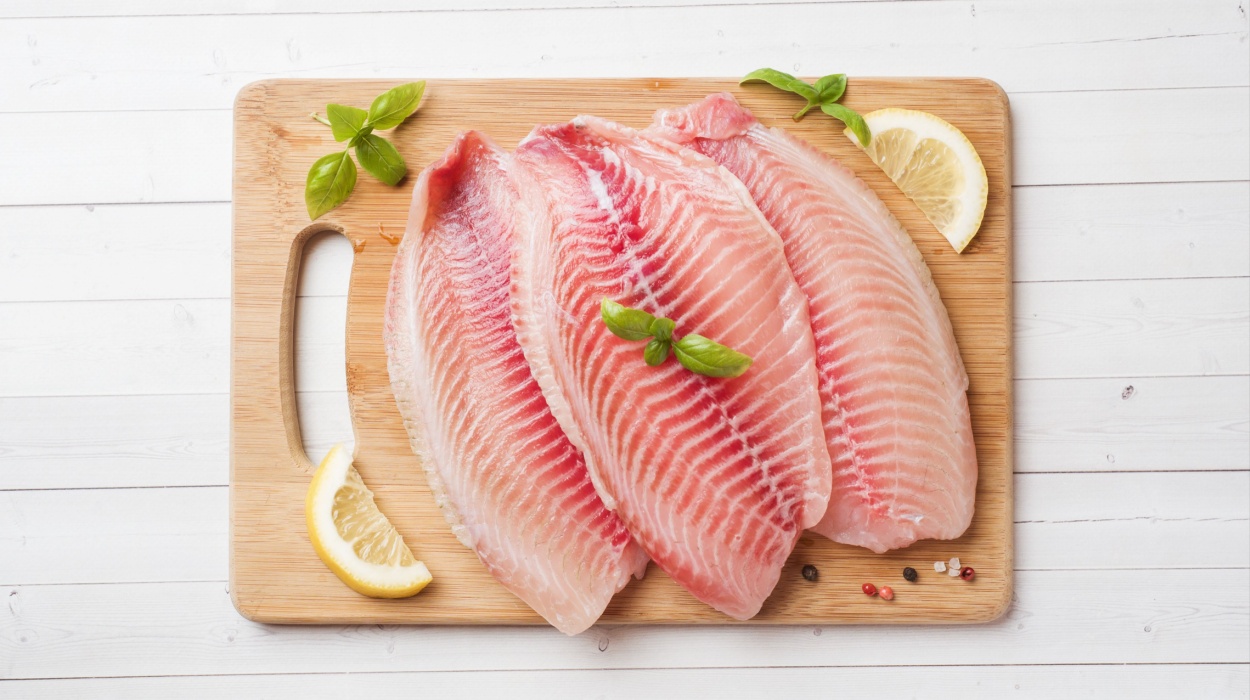 Evidence Based
Evidence Based
Evidence Based
This article is objectively based on relevant scientific literature, written by experienced medical writers, and fact-checked by a team of degreed medical experts.
Our team of registered dietitian nutritionists and licensed medical professionals seek to remain objective and unbiased while preserving the integrity of any scientific debate.
The articles contain evidence-based references from approved scientific sites. The numbers* in parentheses (*1,2,3) will take you to clickable links to our reputable sources.
Is Tilapia Healthy? 6 Benefits & Potential Side Effects 2024

Tilapia is a fish native to the Middle East and Africa. It is currently farm-raised worldwide, making it convenient, cheap, and easy to find. It is the fourth most consumed seafood in the USA. There are three main species of tilapia, but The Nile (black) tilapia, Oreochromis niloticus, also known as the Nile mouthbrooder, is the most commonly farmed tilapia.
Tilapia has a sweet and mild flavor that makes it easy to include in a healthy and well-balanced diet of whole grains, fruits, vegetables, and lean meats. Eating tilapia lowers health risks. It is lean, averaging only 3 grams of fat per serving, and it is an excellent source of protein full of many essential vitamins and minerals. Read on to learn more about this versatile fish that many call the ‘chicken of the sea’.
Is Tilapia Good For You?
Yes. Tilapia contains more essential fatty acids like omega-3s than beef, chicken, pork, or turkey. It is lean and high in protein. Eating fish aids in building bone and muscle, balancing hormones, digestion, healing, and transporting oxygen. It lowers your risk of inflammatory diseases, heart dysrhythmias, blood clots, strokes, and congestive heart failure. Tilapia is a great thing to add to your diet.
Tilapia is very high in nutritional content. It will help your get your daily value of vitamins and minerals, including choline, niacin, vitamin B12, vitamin D, selenium, phosphorus, niacin, potassium, omega-3s
Tilapia Benefits

Prevent Cancer
People that eat moderate amounts of seafood may lower their risk of cancer. It has a very high nutritional value that helps your immune system to work at its best. Tilapia is also very rich in selenium. This essential antioxidant reduces inflammation and may hinder the development or spread of cancer cells.
Support Heart Health
Tilapia is not as high in omega-3s as other fatty fish, but it is still considered heart-healthy. It is very low in cholesterol and especially saturated fats, which makes it good for the heart and preventing blood clots. It is also very high in protein. Calcium levels in tilapia also help with cardiac contractions. Tilapia is good for overall heart disease risk.
Improve Bone Strength
Tilapia contains high amounts of Vitamin D, calcium, phosphorous, and magnesium which makes it a super food for your bones. These vital minerals help to enhance bone density. Eating this fish may also help heal damaged bones and the collagen in tilapia may help heal wounds.
Improve Brain Function
Eating moderate amounts of tilapia may help your brain[1] function better. The high density of vitamins and minerals may also help in decreasing cognitive declines, such as dementia or Alzheimer’s disease. This is especially important as you age.
Boost Better Metabolism
Tilapia is great for weight loss. It is very low in calories and fat and is a great way to add a healthy option to your diet regimen. This fish is high in protein to keep your muscles healthy. The other essential vitamins and minerals keep you full of energy.
Improve Immunity
Tilapia is high in selenium and is essential for the proper function of the immune system. It can improve the working force of your white blood cells. Selenium is also vital for proper thyroid function and DNA repair, and better reproductive health.
What Is Tilapia?

Tilapia is an inexpensive, mild-flavored freshwater fish. It is one of several species belonging to the Cichlid family. Its low price and rapid life cycle have made it the most commonly farmed fish worldwide.
Tilapia is primarily a vegetarian species, with over 90% of their diet consisting of algae, diatoms, and aquatic macrophytes. They have also been known to eat aquatic insects, crustaceans, and fish eggs, although this does not comprise the majority of their diet.
The popularity of tilapia is worldwide. They do well being farmed because they survive and thrive in overcrowded and poor-quality water. They do not tolerate cold water and need to be farmed in warmer climates. Some farming practices vary by location, raising both safety and ethical concerns.
Is Tilapia Bad For You?
There are many health benefits of eating tilapia, but you may also choose to avoid fish which comes with certain risks. Why might tilapia be bad for you?
Opponents of tilapia argue that unsafe farming practices make farm-raised fish bad for you. Because they are mass-produced in crowded, commercial fish farms, this overcrowding can lead to disease.
The waters that fill the indoor recirculating tanks have also been found to have high contaminants, such as heavy metals. This is particularly true of fisheries near industrial parks, where heavy metals and cancer-causing chemicals can pollute the water.
Tilapia are filter-feeding fish in their natural environments. Unfortunately, some tilapia farmers feed their fish stock with the feces of livestock animals. The feeding method of tilapia being fed feces may lead to contaminated waters.[2] Unsafe processing practices and eating raw tilapia can lead to salmonella[3] poisoning and other food-borne illnesses.
Often, farmed fish are fed antibiotics because in overcrowded environments they are prone to disease. Ingesting these antibiotics may be harmful to humans.
Another risk is consuming dioxins,[4] which have been found in tilapia fish farms and are known to cause cancer in humans. The feed these fish are provided must meet regulated standards[5] to keep humans safe. Dibutyltin, a chemical found in PVC plastic, has also been found in farm-raised tilapia. When ingested by humans, this chemical increases the risk of inflammation, asthma, arthritis, and allergies. It also weakens immunity and causes metabolic disorders.
Tilapia Side Effects
The most common seafood-borne illness in the US is scombroid poisoning.[6] Although it is more common in darker fish like tuna and mackerel, a few cases have been reported in humans secondary to tilapia consumption. This poison, also known as histamine fish poisoning, causes an anaphylaxis-like reaction. Sudden onset of symptoms may include difficulty breathing, bronchospasm, low blood pressure, hives, and flushing.
Other symptoms may occur over 12-48 hours, including rash, headache, diarrhea, abdominal pain, blurred vision, and dizziness. For most people, the prognosis is good with anti-histamine administration. Improper handling, including inadequate storage and refrigeration of fish, leads to bacterial overgrowth and scombroid poisoning. Once the histamine forms in the fish, refrigeration, freezing, or cooking can eliminate it.
Rare cases of saxitoxins can be absorbed by tilapia in waters where these bacteria accumulate, leading to paralytic shellfish poisoning.
In addition to farming practices, tilapia contains more omega-6 fatty acids than omega-3 fatty acids. Omega-6 fatty acids are a less healthy fat, and the amount found in tilapia is more than in bacon. The problem with this is that omega-3s and omega-6s should be in a normal ratio, and consuming more omega-6s can imbalance that ratio.
Fish oil is also a natural anticoagulant. Increased consumption may increase your risk of bleeding, especially if you are on anti-clotting medication (anticoagulants). Moderate consumption of tilapia is essential.
Safe Ways To Eat Tilapia & Alternatives
The best tilapia[7] is fresh-caught, not farmed. If you do get farmed tilapia, be sure that the fish is farmed in the proper conditions. Also, ensure that it has been stored/refrigerated correctly and is cooked thoroughly.
Tilapia is considered one of the best fish for pregnant or breastfeeding women and children because of its low mercury levels compared to other species of fish. It is also high in many vital nutrients. There is scientific evidence that shows that eating fish during pregnancy[8] is essential for a baby’s cognitive development.
To see the most nutritional benefits, the FDA recommends you eat at least 8oz of seafood every week. Most people who are eating higher levels of fish are known to consume a healthy, well-balanced diet, including:
- Fruits and vegetables
- Whole grains
- Low-fat dairy
- Nuts, seeds and legumes
- Lean meats
Their diets are also lower in highly processed foods, meats, and sugars. The best way to cook tilapia is to bake it or grill it rather than pan-frying it. If you choose to pan-fry it, try using a healthier oil such as extra-virgin olive oil or avocado oil. Though tilapia is very mild in flavor, you may prefer other fish such as salmon, tuna, sardines, cod, trout, sea bass, Alaskan pollock, mackerel, flounder, and rockfish. These alternatives contain more omega-3s than tilapia.
Another fantastic alternative to tilapia is Lingcod.[9] It is considered the most versatile fish in the world. It has a very light flavor and is found in products everywhere, from imitation crab to fast-food fish sandwiches. Millions of tons of Lingcod are harvested from the fresh waters of Alaska every year.
Final Thought
Both the Food and Drug Administration and the Environmental Protection Agency issue advice to consumers when it comes to eating fish. It is important to be aware of where your fish is coming from. Avoiding farmed tilapia from China, the world’s largest producer, is highly recommended because their farming practices present the greatest concerns.
The best and safest farmed tilapia comes from the US, Canada, the Netherlands, Ecuador, and Peru. Even if tilapia is caught in the US but processed in another country, the foreign country of processing must appear on the package as the ‘country of origin’, according to the Country of Origin Labelling Program, which is enforced by the USDA’s Agricultural Marketing Service.[10] Look for the Ocean Wise symbol on the packaging.
If you can find it, wild tilapia is the best. Unfortunately, in the US, wild and organic production of tilapia is less than 1%.
Like anything else, moderate consumption of tilapia is the best. Try and eat it only occasionally while incorporating other fish for the most health benefits. With these caveats in mind, choosing tilapia is nutritious, safe, and sustainable.
+ 10 sources
Health Canal avoids using tertiary references. We have strict sourcing guidelines and rely on peer-reviewed studies, academic researches from medical associations and institutions. To ensure the accuracy of articles in Health Canal, you can read more about the editorial process here
- Kokubun, K., Nemoto, K. and Yamakawa, Y. (2020). Fish Intake May Affect Brain Structure and Improve Cognitive Ability in Healthy People. Frontiers in Aging Neuroscience, [online] 12. doi:10.3389/fnagi.2020.00076.
- Gale, F. and Buzby, J. (2009). Imports From China and Food Safety Issues. [online] Available at: https://www.ers.usda.gov/webdocs/publications/44390/eib-52.pdf?v=4844.7
- WANG, C.-L., CHEN, B.-Y., HSU, C.-T., WU, R. and CHOU, C.-H. (2019). Salmonella Contamination in Ready-to-Eat Tilapia Sashimi Processing Plants. Journal of Food Protection, [online] 82(2), pp.256–261. doi:10.4315/0362-028x.jfp-18-324.
- World (2016). Dioxins and their effects on human health. [online] Who.int. Available at: https://www.who.int/news-room/fact-sheets/detail/dioxins-and-their-effects-on-human-health
- Center (2020). Animal Feed Regulations. [online] U.S. Food and Drug Administration. Available at: https://www.fda.gov/animal-veterinary/animal-health-literacy/animal-feed-regulations
- Edigin, E., Lingamaneni, P., Sarmiento, J., Shaka, H. and Patel, S.A. (2019). Tilapia Consumption and Scombroid Poisoning. Cureus. [online] doi:10.7759/cureus.5976.
- ADVICE ABOUT EATING FISH. (n.d.). [online] Available at: https://www.fda.gov/media/102331/download.
- Center (2022). Advice About Eating Fish. [online] U.S. Food and Drug Administration. Available at: https://www.fda.gov/food/consumers/advice-about-eating-fish
- Stoneham, T.R., Kuhn, D.D., Taylor, D.P., Neilson, A.P., Smith, S.A., Gatlin, D.M., Chu, H.S.S. and O’Keefe, S.F. (2018). Production of omega-3 enriched tilapia through the dietary use of algae meal or fish oil: Improved nutrient value of fillet and offal. PLOS ONE, [online] 13(4), p.e0194241. doi:10.1371/journal.pone.0194241.
- Usda.gov. (2021). A Tale of a Fish from Two Countries. [online] Available at: https://www.usda.gov/media/blog/2016/12/05/tale-fish-two-countries



